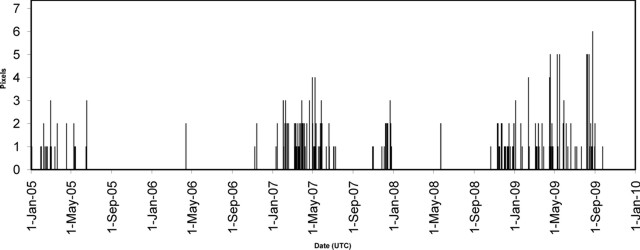Report on Ambrym (Vanuatu) — November 2009
Bulletin of the Global Volcanism Network, vol. 34, no. 11 (November 2009)
Managing Editor: Richard Wunderman.
Ambrym (Vanuatu) Frequent thermal anomalies from lava lakes during October 2008-September 2009
Please cite this report as:
Global Volcanism Program, 2009. Report on Ambrym (Vanuatu) (Wunderman, R., ed.). Bulletin of the Global Volcanism Network, 34:11. Smithsonian Institution. https://doi.org/10.5479/si.GVP.BGVN200911-257040
Ambrym
Vanuatu
16.25°S, 168.12°E; summit elev. 1334 m
All times are local (unless otherwise noted)
Lava lake activity in both summit craters at Ambrym has been documented by the frequent presence of thermal anomalies, detected by MODIS instruments and processed by MODVOLC, between 21 October 2008 and 24 September 2009 (figure 20). Prior to this eruptive episode, the active lava lakes caused detectible thermal anomalies in November 2006 (BGVN 32:05), January-July 2007 (BGVN 34:01), and October-December 2007 (BGVN 34:01).
Ash plumes reported on 25-26 March 2009 resulted in advisories to aviators issued by the Wellington Volcanic Ash Advisory Centre (VAAC). The airport control tower in Port Vila, Vanuatu, informed the VAAC on 25 March of an ash plume that rose to an altitude of 2.1 km and drifted about 55 km S. A pilot report the next day noted "smoke" rising to 2.4 km altitude. Although ash was not visible on satellite imagery analyzed by the VAAC on those days, thermal anomalies were seen in MODIS data on 25 March.
Additional plumes described by the NASA Earth Observatory were seen in visible MODIS imagery on 6 October and 3 December 2009. On both days the light-colored plume initially drifted 65 km WNW towards Malekula island. On 6 October the plume became a broad diffuse plume that spread hundreds of kilometers NW across the Coral Sea.
Geological Summary. Ambrym, a large basaltic volcano with a 12-km-wide caldera, is one of the most active volcanoes of the New Hebrides Arc. A thick, almost exclusively pyroclastic sequence, initially dacitic then basaltic, overlies lava flows of a pre-caldera shield volcano. The caldera was formed during a major Plinian eruption with dacitic pyroclastic flows about 1,900 years ago. Post-caldera eruptions, primarily from Marum and Benbow cones, have partially filled the caldera floor and produced lava flows that ponded on the floor or overflowed through gaps in the caldera rim. Post-caldera eruptions have also formed a series of scoria cones and maars along a fissure system oriented ENE-WSW. Eruptions have apparently occurred almost yearly during historical time from cones within the caldera or from flank vents. However, from 1850 to 1950, reporting was mostly limited to extra-caldera eruptions that would have affected local populations.
Information Contacts: Hawai'i Institute of Geophysics and Planetology (HIGP) Thermal Alerts System, School of Ocean and Earth Science and Technology (SOEST), Univ. of Hawai'i, 2525 Correa Road, Honolulu, HI 96822, USA (URL: http://modis.higp.hawaii.edu/); Wellington Volcanic Ash Advisory Centre (VAAC), Meteorological Service of New Zealand Ltd (MetService), PO Box 722, Wellington, New Zealand (URL: http://www.metservice.com/vaac/, http://vaac.metservice.com/); NASA Earth Observatory (URL: http://earthobservatory.nasa.gov/).


